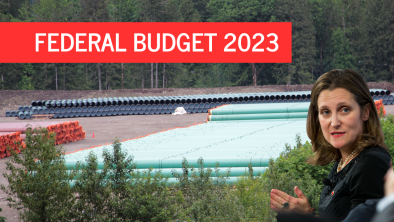2015: A Pivotal Year For Canada’s Clean Tech Sector
Clean Technica
Canada is at a crossroads. Natural Resources Minister Jim Carr suggests our reliance on fossil fuels will soon be a memory. The future lies with renewables. There are numerous challenges to be overcome. The latest installment of Tracking the Energy Revolution looks at 2015: a pivotal year for Canada’s clean tech sector.
Pivotal Year For Canada’s Clean Tech Sector
“Our work is formed in large part by Canada’s 2030 climate target and ambitions to reduce emissions. We look at modelling like the Pathways To Decarbonization that Dave Sawyer did, or the Trottier Energy Future Project. They ran a lot of different scenarios for Canada to achieve these projections. In all of these scenarios, we see an increase of electricity within our energy systems. We see the electrification of transportation, heat for buildings, and industrial processes. So even with a really ambitious energy efficiency agenda, where we would see energy productivity doubling, we still see a near doubling in electricity generation to support that electrification of the economy,” said Dan Woynillowicz of Clean Energy Canada.
BC’s $50 Billion Commitment
His opinion is not shared by all Canadians.
In British Columbia, for example, there are questions regarding commitments to purchase over $50 billion of unnecessary electricity.
“A huge portion of BC Hydro’s deferred debt, around $50-$55 billion, is in energy purchase agreements to independent power projects (IPP), and electricity usage has pretty much flatlined since about 2008 – when we had the big recession,” said Gwen Barlee, of the Wilderness Committee.
BC Hydro denies this, of course, “IPPs are a critical part of our plan to be self-sufficient. Independent power projects provide about 25% of British Columbia’s electricity and make up about 28% of our costs. BC Hydro would have a significant shortfall without this energy and capacity.”
Barlee responded, “When you have a BC Hydro spokesperson speaking about IPPs, they have to keep in mind the B.C. Government has given them marching orders and they are supposed to say good things about IPPS.”
Adrian Dix, the New Democratic Party critic for BC Hydro, explained:
“The Liberal Government bought power we didn’t need, that benefited friends of the Liberal Government. We bought too much power and we bought it for years to come. Some of the contracts that BC Hydro signed with these IPPs (independent power producers) guarantee that they will be paid for 35 years. So this is what they mean when they talk about $50 billion in contractual obligations.”
(My interviews with Barlee, Dix, and the BC Hydro spokesperson are taken from another article, and radio podcast, which you can access here)
Site C Dam
Though the issue of IPP contracts was new to Woynillowicz, he did comment on the controversial $12 billion Site C Dam project.
“We would look at the economics of that project and scratch our heads. Is that really the best approach? B.C. has other abundant opportunities to incrementally build renewable energy capacity as it is needed, closer to where it is needed, and over time”
Replacing Fossil Fuels For Heat & Transportation
He added that the province presently obtains most of the energy for heat, transportation, and other industrial processes from fossil fuels.
“If British Columbia moves to electrify those energy services, and that is consistent with the recommendations of the Climate Leadership Team, that could lead to an additional demand of about 5,000 Gigawatt hours (GWh) over the next fifteen years. That is about on par with the size of Site C.”
Similar Stories From Ontario
British Columbia is not the only province where there are allegations of financial mismanagement.
A recent article in the National Post quotes Auditor general Bonnie Lysyk stating that Ontario ratepayers will pay billions of dollars because of provincial mismanagement.
Woynillowicz had not read the Auditor’s report, but has heard that there are questions about the fairness of media coverage.
“Unfortunately Ontario has a history of political mismanagement of the electricity system hat goes back for decades,” he added.
The National Post story accurately portrayed some details. Here are examples, drawn from the Auditor’s report itself:
” … We calculated that electricity consumers have had to pay $9.2 billion more (the IESO calculated this amount to be closer to $5.3 billion, in order to account for the time value of money) for renewables over the 20-year contract terms under the Ministry’s current guaranteed- price renewable program than they would have paid under the previous procurement program.”
” … Hydro One’s transmission system reliability has worsened in the five years from 2010 to 2014, with outages lasting 30% longer and occurring 24% more often.”
” … Ontario currently has an oversupply of electricity, with its available supply exceeding its maximum hourly consumption by an average of 5,160 MW per year from 2009 to 2014—an amount approximately equal to the total existing power generation capacity of the province of Manitoba.”
Solutions For Ontario
Woynillowicz pointed out that the province has found markets for its surplus electricity south of the border.
“One of the challenges that Ontario has had, at times, is surplus generation when there isn’t a lot of demand in the market. So they were exporting at a loss. This is one of the reasons they are procuring energy storage. They can save that excess generation to use it when they need it. Or they can export that excess, when it is profitable to do so,” he said.
He suggested this surplus electricity could also be used power a cleaner transportation sector.
The Post did not report the Auditor’s recommendations of areas where large sums should be spent. Approximately $4.5 billion worth of transmission assets need to be replaced because they “exceeded their planned useful service life.” The province also needs, “a detailed technical plan” to ensure future actions are both “prudent and cost-effective.”
The Need To Transition
Utilities are facing similar issues throughout North America. The grid is aging. The cost of replacing it is enormous.
Smart grid and energy storage companies suggest this is also unnecessary. The same technologies that make the adoption of more intermittent technologies possible can give new life to existing infrastructure.
“We think all of these things can be done better. Not by spending another dollar on hardware equipment, but by spending another 10 cents on software and algorithms,” said John Jung, CEO of the energy storage software, services & systems company GreenSmith.
The challenge in Ontario, British Columbia, and the rest of Canada isn’t so much the money being spent, as it is ensuring it is used wisely.
On The Threshold Of 1.5 Degrees
In addition to aging, Canada’s grid is also overly reliant on fossil fuels.
A number of climate scientists have pointed out that we are on the threshold of an average global temperature that is 1.5 degrees C above that of the pre-industrial era.
“The warming is not uniform, these are values that are averaged over the globe. So if we look at a map of the warming, what we see is the warming is much worse in the Arctic. In those regions, temperature records were broken by two digits this winter. This means some temperatures in Alaska or close to the Arctic circle actually being ten to twenty degrees warmer than the average and previous year,” explained Dr Kirsten Zickfeld, a climate scientist at Simon Fraser University.
She added, “If leaders on the federal level, and the provinces, are serious about meeting the targets they agreed to in Paris, then there is no room for pipelines or any other fossil fuel infrastructure.”
A joint University of East Anglia/British Antarctic Survey study subsequently reported that carbon dioxide concentrations have reached the critical point (400 parts per million).
“Emissions need to decrease to near zero to stop the rise in CO2 at Halley and elsewhere and to control climate change. We have all the solutions at our finger tips, we now just need to take action,” said Prof Corinne Le Quéré, director of the Tyndall Centre for Climate Change Research at UEA.
Canada’s Accomplishments
Tracking the Energy Revolution chronicles Canada’s accomplishments on the road to a carbon-free infrastructure.
“Over the past five years, more than $45 billion has been spent to build new renewable energy projects across Canada. Most of those dollars have gone into wind ($19.4 billion), large hydro ($13.8 billion) and utility-scale solar projects ($8.4 billion).”
Provincial utilities like Hydro Québec, BC Hydro, and Ontario Power Generation already use large quantities of renewable energy. Their installed capacities are 36,100 MW, 11,826 MW, and 6,426 MW, respectively.
Yet Canada continues to lag behind in the development of her own renewable resources. Two years ago, Clean Energy Canada pointed out that four of the top five investment firms funding this transition were German or Japanese. This year, they showed that three of the top five corporate renewable developers are foreign companies.
A Pivotal Year
“This is a pivotal time in Canada’s clean energy transition, and the steps we take now now will have a huge bearing on how quickly we make that transition — and how much we’ll benefit from it,” said Merran Smith, Executive Director of Clean Energy Canada. “We’re living in a new era of political resolve to tackle climate change. As Alberta and Saskatchewan add more clean power to their grids, and as Ottawa announces new measures that support electrification, spending on clean energy will likely grow again in the years ahead.”
“Last year, nearly a third of a trillion dollars was invested globally in renewable power, nearly 50% more than was invested in power from fossil fuels. That’s a trend that will continue to grow, and it’s one that represents a tremendous opportunity for Canada, and for the world — one we cannot, and will not, ignore,” said Prime Minister Justin Trudeau.
As Clean Energy Canada points out, 2015 was a pivotal time in the nation’s clean energy transition. Prior to this, the federal government was essentially missing in action. Our new Prime Minister at least recognizes climate change is a threat and has taken the first steps towards formulating a response.
Some question whether his government is willing to go far enough.
As Dr Zickfeld reminds us, it takes decades for climate change impacts to manifest. “Even if we stopped emissions tomorrow, the … (change would not be noticeable) for a very long time …”
She has hope for the future.
“Had you asked me a year ago, I would have been much more pessimistic. I think it is possible to tackle climate change and avoid the worst of it, but this only works if everybody does something.”
View the full article here


